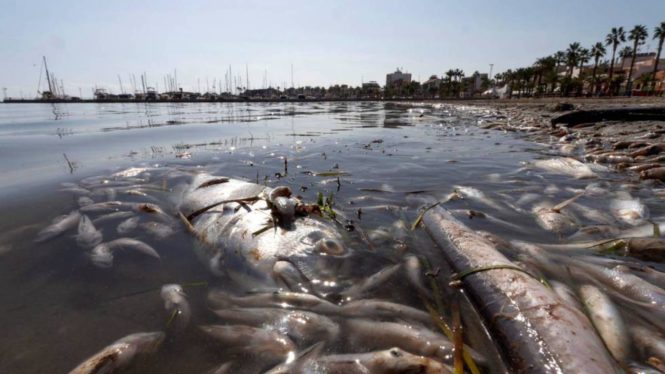One of the most distressing ecological disasters of the local area is that of the Mar Menor, which was recently shown to have been caused due to the nitrates used in agriculture. But there is a group of experts brought together in the Agroingenieros por el Mar Menor collective that is willing to challenge that. To do this, they presented a pioneering report that demonstrates, with data, how the pollution of the lagoon located in the region of Murcia responds, pre-eminently, to wastewater.
The report begins by noting that between 50% and 80% of the wastewater generated worldwide is discharged into bodies of water, so these -wastewater- are always “the first or second factor of contamination.” This is how the agronomist Pedro Fernández defends it: “It happens like this in all the coastal lagoons except in the Mar Menor of the Region of Murcia, what a coincidence…”.
The report, in which Fernández has participated in drafting, and which was presented this Wednesday in Murcia, shows the high presence of wastewater in the Mar Menor, as well as its impact on the current situation in La Laguna. What these experts intend is to demonstrate how the pollution problem is multifactorial, and that the poor sanitation of the network causes continuous discharges of wastewater, well above the permitted levels.
This would provoke the now recurring images of fish suffocating from lack of oxygen, already a symbol of the ecological collapse of the Mar Menor, the largest salt lagoon in Europe, after decades of institutional mistreatment. And it is that, Fernández points out, the poor state of the sanitation network and the sewage treatment plants that are behind, mainly, this disaster.
The report concludes that in order to act and reverse the current state of the Mar Menor, the key pressures must be redefined: “That is why other models must be used and the degree of affectation of the residual waters in the lagoon must be defined through its three entry routes: sizing of the riverside purifiers, poor condition of the sanitation network and urbanisations and unconnected urban centres.
“We convincingly demonstrate the presence of ammonium, organic matter and phosphorous. None of the three comes from agriculture, but from wastewater. When it rains, the sewage treatment plants dump untreated water into the Mar Menor, and that is the breeding ground for the growth of phytoplankton”, Fernández abounds, pointing to all these data to show that the diagnosis that has been made so far “is not the right one. We are treating a cancer patient with a diet for cholesterol”.
What, therefore, should be the response to this erroneous analysis or diagnosis has spread like wildfire in recent years? Pedro Fernández, as an agricultural engineer, says that this answer does not correspond to him, but he does dare to point out that “all political parties, scientists and environmentalists talk about nitrate when there is not a single study that demonstrates the relationship between nitrate and mortality of fish”, this being due, he understands, to “anopsia due to the presence of organic matter in the water column”. An organic matter that would come ultimately, and predominantly, from wastewater.
The group of Agroengineers for the Mar Menor is made up of Pedro Fernández Molina, who is a doctor of agricultural engineering; Pedro José Martínez Fernández, agricultural technical engineer; Pompeyo Iváñez Miralles, agricultural engineer; Aurora Conesa Sánchez, agricultural technical engineer; José Luis Angosto Soto, agricultural technical engineer; María Gloria Lara Sánchez, technical agricultural engineer and Encarnación Mercader Ros, technical agricultural engineer.
“We don’t want to whitewash agriculture, or present it as an NGO,” says Fernández, who settles: “We just want the focus to be put on the main factor because our goal is to solve the problem of the Mar Menor.”





